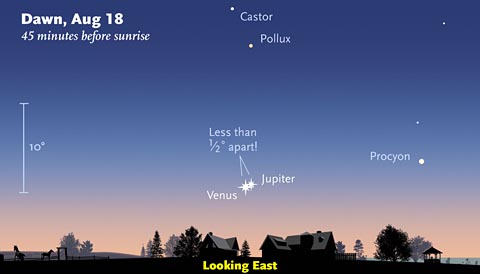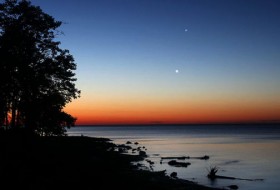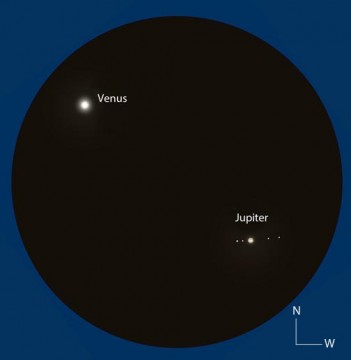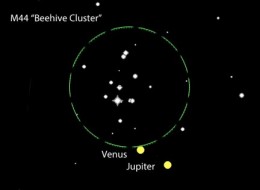Here's your invitation to a spectacular close conjunction of the sky's two brightest planets, Venus and Jupiter, next Monday morning.

Sky & Telescope diagram
Planets pair up plenty often in the sky, but rarely do they dance this closely. During Venus and Jupiter's close conjunction shortly before dawn on Monday, August 18th, they'll be separated by only 1⁄3° or less. It's the very best planet-planet meetup of 2014 — in fact, these two worlds haven't paired so closely since 2000.
And it all happens right next door to Messier 44, the Beehive Cluster, in the constellation Cancer the Crab.
The two planets' tight dance will be brief. Venus is headed toward the eastern horizon and solar conjunction, while Jupiter only recently escaped the glare of the sun. With every morning, Jupiter rises a little higher in the east and Venus a little lower. As the two planets trot off in different directions, we'll see them slowly approach and separate.

Bob King
On August 14th, they'll be just 4° apart some 10° high in the northeastern sky 30 minutes before sunrise. To spot the duo, find a location with an open view nearly down to the eastern horizon.
You can start watching for the Venus-Jupiter conjunction as early as an hour before sunrise, but the planets will be very low and possibly obscured by clouds or haze. Bring along a pair of binoculars just in case. Not sure when the sun rises? Click here and enter your city.
Each following morning, the distance between them shrinks by 1° (twice the diameter of the full Moon) until the 18th, when they'll be about 20 arcminutes (20′) apart, depending where you are in North America. You'll be able to cover both planets with the eraser of a pencil held at arm's length. That's what I call snug!

Source: Stellarium
While conjunctions of Venus and Jupiter occur about once a year on average, they vary considerably in visibility and separation. Some happen in daylight, while others are wide misses.
Proximity makes for exciting conjunctions, and this event is the closest for North America since a similar morning pairing on April 23, 1998, almost an eternity ago. And there's more: The next Jupiter-Venus tango occurs less than a year from now, on June 30th, when they'll be just 20′ apart and conveniently placed in the western evening sky during twilight.
The View Through a Telescope
If you own a telescope, tote it out for a closer look. Both planets will fit with room to spare in the same field of view, a sight not to be missed. Blazing Venus mimics a tiny full moon just 10″ across; Jupiter's three times as wide. Will you be able to spot Jove's two 'tire track' equatorial belts and four moons?

Source: Chris Marriott's SkyMap
With twilight well underway, binoculars should help you track down the Beehive Cluster. I suspect you'll still see its brightest stars — look just to the left of Venus.
As close as this conjunction is for observers in North America, the planets will be even cozier for central European sky watchers. Closest approach of 13′ (0.2°) happens around 5h Universal Time as dawn's first light touches the rugged Alps.
Track Jupiter and its moons in the sky using Sky & Telescope's handy JupiterMoons app.
 8
8









Comments
mary beth
August 14, 2014 at 12:30 am
Great information! I'm looking very forward to the beautiful sight Monday morning! Hope there's clear skies for all! S&T articles are so well-written and easy to understand. I always pick up a fun fact that stays with me, that I pass along to others. It's nice knowing we will see them paired up again within a year! Already have it on next year's calendar! Thank you!
You must be logged in to post a comment.
August 15, 2014 at 10:20 pm
Thank you for this fantastic hedzup.
I worked on some of the research which went into the Galileo project, of course many many many moons ago, but only within the last month I have re-triggered my studies of 'The Giant,' including preparations for viewing.
We've experienced very few clear skies in the past couple weeks but CalSky is forecasting the morning of the 18th to be very good for viewing. The wonderful thing is that now that Jupiter is moving from our Sun's glare there will be many days and nights in the upcoming months for some terrific Jupiter viewing.
Thank you again. don
You must be logged in to post a comment.
richard szweda
August 16, 2014 at 10:06 am
These articles about accessible naked eye/binocular events are great. Bob King does a great job. Very nice to be able to interest the rest of the family in these sorts events, since they are easy to explain and observe with people who have only a passing interest and limited patience, but with still an impressive sight as a reward.
You must be logged in to post a comment.
Glenn
August 16, 2014 at 7:10 pm
This conjunction is a particularly close event and is part of a 24 year cycle. As a kid I saw the August 1966 event, then again in August 1990 and now weather permitting the 2014 apparition. Clear skies to all.... G
You must be logged in to post a comment.
Tony
August 19, 2014 at 5:04 pm
Last Venus-Jupiter conjunction in this cycle to occur more than 60 days before superior conjunction of V. In 2038 V and J will meet on August 23 and superior conjunction of V will be on October 18.
You must be logged in to post a comment.
Tony
August 19, 2014 at 2:23 am
Saw the conjunction from my Vancouver Island home -- like the Cat's Eyes of Scorpius only much closer together -- and brighter! Next up for Venus -- a conjunction with Regulus on September 5. According to Wikipedia this is part of an 8-year cycle in which Venus passes the star around its heliacal rising. But each time Venus and Regulus meet in this cycle their elongation is a little less. My attempts since 1974 to see Regulus during its early September conjunctions with Venus have been unsuccessful but I've always had some unfavourable combination of horizon obstructions and weather.
You must be logged in to post a comment.
Peter Wilson
August 19, 2014 at 12:33 pm
Rained yesterday morning; today was a downpour.
Of course, living in Phoenix, it's 2 B expected.
You must be logged in to post a comment.
Seldom
August 19, 2014 at 2:38 pm
I made a calibrated photo of the conjunction yesterday at 6:00 AM MDT (12:00 UT). My measurement indicated a separation of about 19.5' at that time. Does a table exist showing times and separations, that I could compare my measurements to?
You must be logged in to post a comment.
You must be logged in to post a comment.